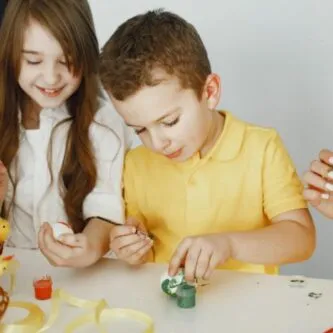
Because of the ongoing pandemic, children are left with no choice but to spend more time indoors. As a result, children who are already easily bored become even more restless. Such a feeling of restlessness is termed cabin fever. Teachers at international schools in Manila do everything within their capability to inject diverse outdoor activities.
As parents, we want our children to use their time more creatively doing activities that help in releasing excess energy. Spending long hours in front of the television or playing video games will not accomplish this goal. However, we cannot just ask our children to stop using their gadgets without introducing activities that will pique their interests. Otherwise, they will release pent-up energy and tension in unacceptable ways such as whining, throwing tantrums, picking fights with siblings, acting out, and roughhousing.
How do you fight children’s boredom during the pandemic?
1) Prioritize physical activities
Let your child play outside where you think it is safe, only for short periods. If this is not possible, allow your kids to play actively indoors. That said, you need to provide opportunities for physical activities. For example, you may put up an adventure room where they can be playfully rowdy. Ensure that there are child-proofing materials and cushions to protect them from getting hurt. Set limits on how rough they can get while inside the room so that they won’t hurt one another.
2) Source creative arts and crafts kit
Online you will find hundreds of crafts and art kits for children to choose from. These kits are usually filled with dynamic and multipurpose supplies and materials such as felt letters, fuzzy sticks, and colorful markers. What is great about these DIY sets is they allow kids to express their creativity. They also present fun opportunities for your child to learn how to construct, sequence, or arrange things to build an object from scratch.
3) Encourage starting a hobby
You may also encourage your child to start a hobby. For instance, they want to learn how to play the ukulele, dance hip hop, or build a rocket. They may want to start a collection. Whatever they want to do, support them. They will need it. For all you know, all they need is a little push from you. Starting a hobby leads to sustaining the child’s interests, and these interests foster your child’s sense of learning and competence.
4) Enroll in enrichment classes
If you cannot go to the library, museum, art gallery, or historical site, check with your community resources. Some examples of these resources are craft centers, recreation centers, youth clubs, and church activities. They may offer enrichment programs that your child may participate in. Some programs provide certificates and prizes that may encourage your child to join. Don’t forget to check the facilities, though. You want your child to partake in activities where he can be safe.
5) Have family games and activities
Steer clear of screens for a while by having family game nights. Ask for their favorite board games and play together. Or, have a picnic or camp in the backyard, complete with s’mores and stargazing. Set up an outdoor movie theater where you may watch your favorite movies together.
However, experts agree that children, especially older ones and teens, should be given leeway. However, screen times are not a free-for-all—children need to understand this simple rule. One way to do this is to…
6) Use screen time constructively
True enough, the pandemic made it challenging to limit screen times, particularly for teenagers. For them, their smartphone is the only thing that bridges them to the outside world, especially their friends. So allow them to use it for school and leisure. For instance, they may use it to engage in dance challenges so that even if they are at home, they are doing different physical activities. If not joining in these challenges, they may use it to participate in photography contests. They may also take pictures and submit them online to kickstart their digital portfolio. Again, focus on your child’s interests. This applies to younger children also. Allow them to play games for 30 minutes after doing their homework or household tasks.
7) Allow them to do household chores
An excellent way to instill a sense of responsibility in your children is by letting them do household chores. Cooking with kids or allowing the kids to prepare one meal a day is an enjoyable family activity. Some kids are keen on learning how to bake or decorate cookies, so let them do it. Offer help, so they are guided in the kitchen too, but let them do things independently. Bottom-line is that you need to encourage and support whatever they want to do in the kitchen. You might be surprised at what your kids can do.
8) Develop a quiet culture
Children regard home as their safe place or their sanctuary. Beating boredom does not necessarily mean being as active as they want to be. Sometimes, downtime is all they need to recharge. Not doing anything may seem unorthodox, but it can help your child structure downtimes. For instance, you may ask your child to sit comfortably in the middle of the room, then ask him to look around and pick one object that interests him. He may describe it in five sentences without touching that object or write a short piece about it. This activity also boosts your child’s creative thinking skills.
Kids will always be kids, but they need not be stricken with the pandemic doldrums. The secret lies in having a little creativity, effort, and flexibility. Look around you and start with what you already have inside the house. Your goal is to provide opportunities for your child that favor pursuing creative alternatives to reduce boredom and, ultimately, cabin fever.






-logo.png)



